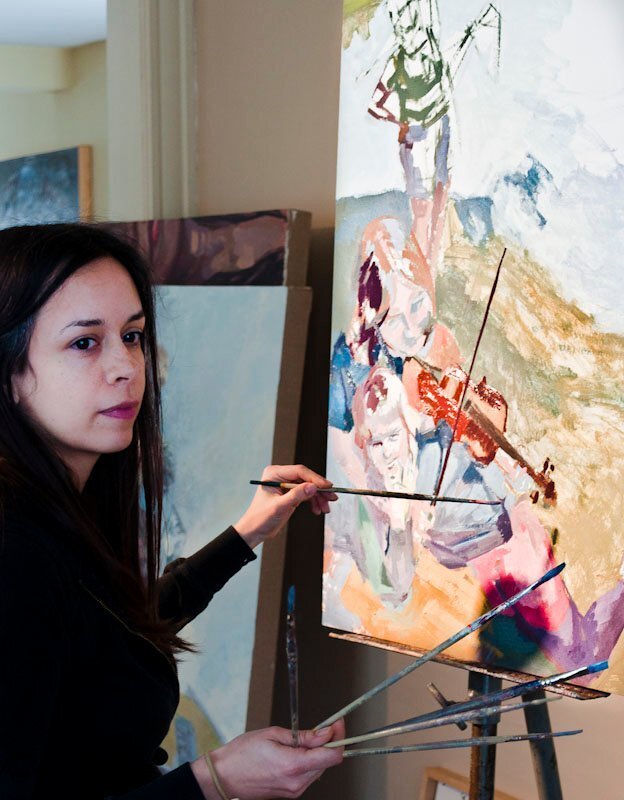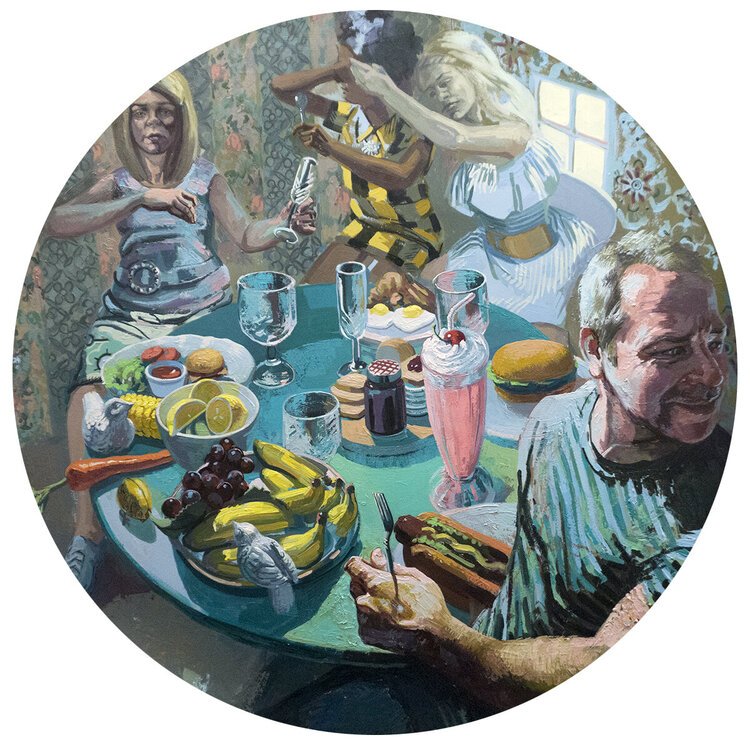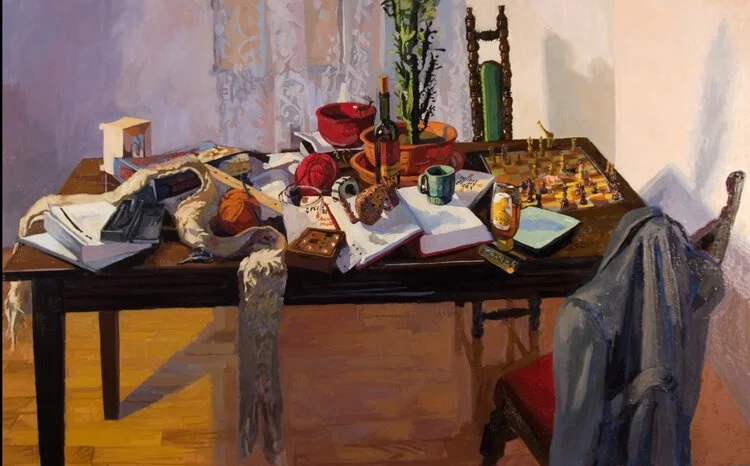Artist Interview: Teresa Dunn
Today we wanted to highlight work of Teresa Dunn, an incredible artist and visionary we had the pleasure of speaking with. We get personal about reconciling the struggle of being born into two cultures, loss of career momentum due to motherhood, and other insightful ideas that define Teresa’s work.
About Teresa Dunn:
Teresa Dunn is a Mexican American artist raised in rural Southern Illinois. Her identity, life, and art is poetically influenced by being suspended between two cultural heritages. Language, space, color, light, and storytelling find expressiveness through moving toward and away from simultaneously contradictory tensions. Gloria Anzaldúa’s “Borderlands” accurately reflects Dunn’s own reconciliation of her mexicansimo with her American-ness and the complexities of growing up and living as multicultural woman in the Midwest.
Teresa Dunn received her MFA from Indiana University Bloomington in 2002. She is a three-time recipient of the Elizabeth Greenshields Foundation Fellowship and received the Jacob K Javits Fellowship from the US Department of Education. Dunn is represented by First Street Gallery in NYC and Galerie l’Échaudé in Paris, France. Recent solo exhibitions include M o t h e r l o a d at the Visual Arts Center at the Washington Pavilion in Sioux Falls, SD in 2017 and First Street Gallery in NYC and Miami University of Ohio in 2016, and Ebb and Ember at Hooks-Epstein Galleries in 2015. Dunn’s 2012 exhibition Strange realities/Étrange réalité at Galerie l’Échaudé was reviewed in French journals AZART and Miroir de l’Art. Dunn was a finalist in the 2000 William and Dorothy Yeck Miami University Young Painters Competition and won Best in Show at the 2008 Biennial of Contemporary Realism at the Fort Wayne Museum of Art in Fort Wayne, Indiana. She has been included in numerous publications including Studio Visits and Paint Pulse Magazine. Dunn was accepted for the inaugural year of the Cuttyhunk Island Artist Residency with featured artist Alex Kanevsky in 2017. She has conducted many visiting artist lectures including the most recent 2017 lecture and student critiques at the Rome Art Program in Rome, Italy. Teresa Dunn is currently an Associate Professor of Painting and Drawing at Michigan State University in East Lansing where she has taught since 2006.
Teresa, you discuss reconciliation of mexicanismo with American-ness in your work. Can you tell us little more about that?
Listening to Code Switch on NPR a couple years ago I learned about what they described as the Racial Impostor System which was defined by the podcast as the feeling of inauthenticity or general lack of belonging to one or more cultures of which bi-racial or multicultural persons are a part. The episode resonated with me; it pinpointed part of my experience from childhood through the present that I never really had a name for. My mom is Mexican born and I was raised a largely white small town in Southern Illinois. My family embraced Mexican and American traditions. Though both cultural heritages played strong roles in my life, I never fully identified as, nor felt accepted as, completely American or Mexican. This created internal and external tensions with confusion about where I belonged culturally that still trouble me.
What are some complexities in regards to that you experience, and how do you rectify that in your work?
My identity is defined by culturally disconnected experiences rooted in appearance, ritual, language, food, and genetics. Always aware of my dual origins I was simultaneously proud of and puzzled by them. I was called Teresita (little Teresa), mispronounced by everyone outside my immediate family. My mother frequently gave me two braids in my hair until I was around 10, she thought they made me beautiful and was proud of them. I felt self-conscious in them, but didn't understand why at the time. I just knew that when my mom sang to me in my braids "Una indita muy bonita" (a beautiful little Indian girl) I cringed. Looking back, I didn't want to be an indita, I wanted to be a classic American girl like my friends. My parents spoke Spanish to each other but not to us children. Though I acquired Spanish in young adulthood, my skills are not native. I feel self-conscious because of that as it affirms me as a gringa to my Mexican family. Traditions in our home were mixed—not Mexican enough to fit in my mother’s homeland and just enough off from American friends and family to feel like and be an outsider in my own country. I was also the only brown person in my immediate family. And I failed to see my own color. My town, family, role models—my community mirror was White. Being brown startled me when I saw myself in photos or heard others reference my skin color because clearly others noticed my skin. I endured disparaging names like “taco,” “half breed,” “wetback,” and “dark meat,” in my younger years. As an adult I'm peppered with questions like, “What are you?” “Are you part Native/Black/Asian?” “Where are you from?” “Did you go to the beach this weekend?” Usually, these questions are from total strangers, who feel compelled to stop me in the middle of a store, on the street, at a party and attempt to identify me. I believe this is because they recognize that I'm somehow not part of the group. It always catches me off guard. It is always painful.
The second part of your question is harder, because in large part I haven't really dealt with it in my work in a conscious way until recently. In large part I was really in denial that I was struggling over this part of my identity. In the last few years, I accept that a large part of who I am and what I make has been about disconnect, absurdity, non sequitur, and relationships that misalign. I am currently working on a series of paintings called Suspended: Between the American Reality and the American Dream, though, that deal with these issues head on. Instead of focusing solely on my personal struggle, I am painting the stories of other people with complex racial and cultural identities, too.
"In Dreams" resembles collages of mundane yet significant scenes from every day life. Can you tell us a bit about your intentions with this body of work?
I've always been interested in the mundane and the everyday. I'm not sure that I can pinpoint why, but there is something fascinating about what the ordinary can reveal. During the time I was making the works in "In Dreams" I was reading a lot of Gabriel Garcia Marquez. I loved magical realism and how the absurd and extraordinary could be woven into stories where the magical was accepted as normal. Maybe the idea of absurdity and disconnection plays into the collage feel. But it was also the first time I was really painting using photographic sources and not just life observation. I had been committed to direct life observation for so long and needed to tell stories that I couldn't by just looking at the world around me. I had just left a nearly decade long relationship and was very aware about the daily, because it had changed so significantly for me. For the first time in my life, I lived alone. The absences and empty spaces were just as potent as the full. I didn't want to look at the world around me because it was too painful. So using photos and other digital sources became part of that. It seems so simple looking back but its impact was huge in terms of the kinds of stories I wanted to and was capable of telling.
You are an Associate Professor at MSU currently, how has your work changed during COVID? How did you adapt?
This is a hard time. I am the mother of an 8-year-old girl who is doing online school while I am teaching online. We have mostly found a rhythm. But it involves mostly being online. That is terrible, for both of us. I have had little time for anything except teaching. I feel like I'm failing at being a good mom and being a painter. Most of what I have painted is in short spurts. 30 minutes here, an hour there. At the beginning of the shut down in Michigan I was reeling from learning about the unexpected death of a great friend and painter. I was mourning his loss, mourning the loss of pre-pandemic life and the way our lives were so suddenly changed. At the time no one knew how long it would continue. There was so much fear and uncertainty. I made a painting called #COVIDelicious. As a way to try to deal with the grief of so much lost I imagined a meal I would eat with people I was separated from due to death, distance, and quarantine. Each dish is dedicated to specific people or a larger representative group. In this time of separation and distancing, this painting finds solace in setting the table for the day we can be together again without fear. Now as we are approaching the end of the fall semester, I'm painting a little more often, a few hours a couple times a week. It isn't nearly enough, but it is all I have. My daughter and I have to support each other in these days of isolation, so I can't be in my studio all the time.
We are strong believers that the more people discuss failure, the less significant the possibility of it becomes. Often times simple roadblocks are mislabeled as failure too! In our society, we are so terrified of possibility of something not working out, that it halts all our efforts to begin with. We ask all of our interviewees if they can share a time where something (a project or opportunity) did not work out and how did you move forward?
This is such an important question! When I was pregnant with my daughter, I had my first international solo show in Paris. It was a wonderful experience. It sold well and the show was reviewed in a couple French journals. Subsequently I was offered an exhibition at another gallery in Nantes. After my daughter was born though I was not capable of following through with that opportunity. My professional career lost a huge amount of momentum when I became a mother. I felt like an artistic and professional failure and had trouble coping with feeling like I wasn't succeeding at any aspect of life. It took me a long time to get past that. I had to redefine what it meant to be a success, and stop comparing my own record and accomplishments with others. I'm still feeling like I'm not exactly where I wish I were, but maybe if I had nothing to aim for, the journey would be over. I also, do not regret becoming a mom and am grateful for what motherhood has taught me and how it has changed my work, my teaching, and my perspective on quality in life.
Any events, projects, or exhibits you'd like to share with the audience? Has any of them cancelled due to COVID?
I've had several shows postponed because of COVID, they've been rescheduled and will resume hopefully in 2021 and 2022: University of Alabama Huntsville, Pendleton Art Center in Oregon, and the Marathon Center for Performing Arts in Findlay, Ohio. I have a piece in an upcoming group show Disrupted Realism featuring Anne Harris and juried by John Seed at the Buckham Gallery in Flint, Michigan. I also referenced my current painting project: Suspended: Between the American Reality and the American Dream. The first exhibition it is slated for is the Dennos Museum in Traverse City, Michigan in 2023. It will probably also show at First Street Gallery in New York.
People can find my work on my website: www.teresa-dunn.com
Instagram: @teresa.m.dunn
Thank you so much for asking such great questions!!






